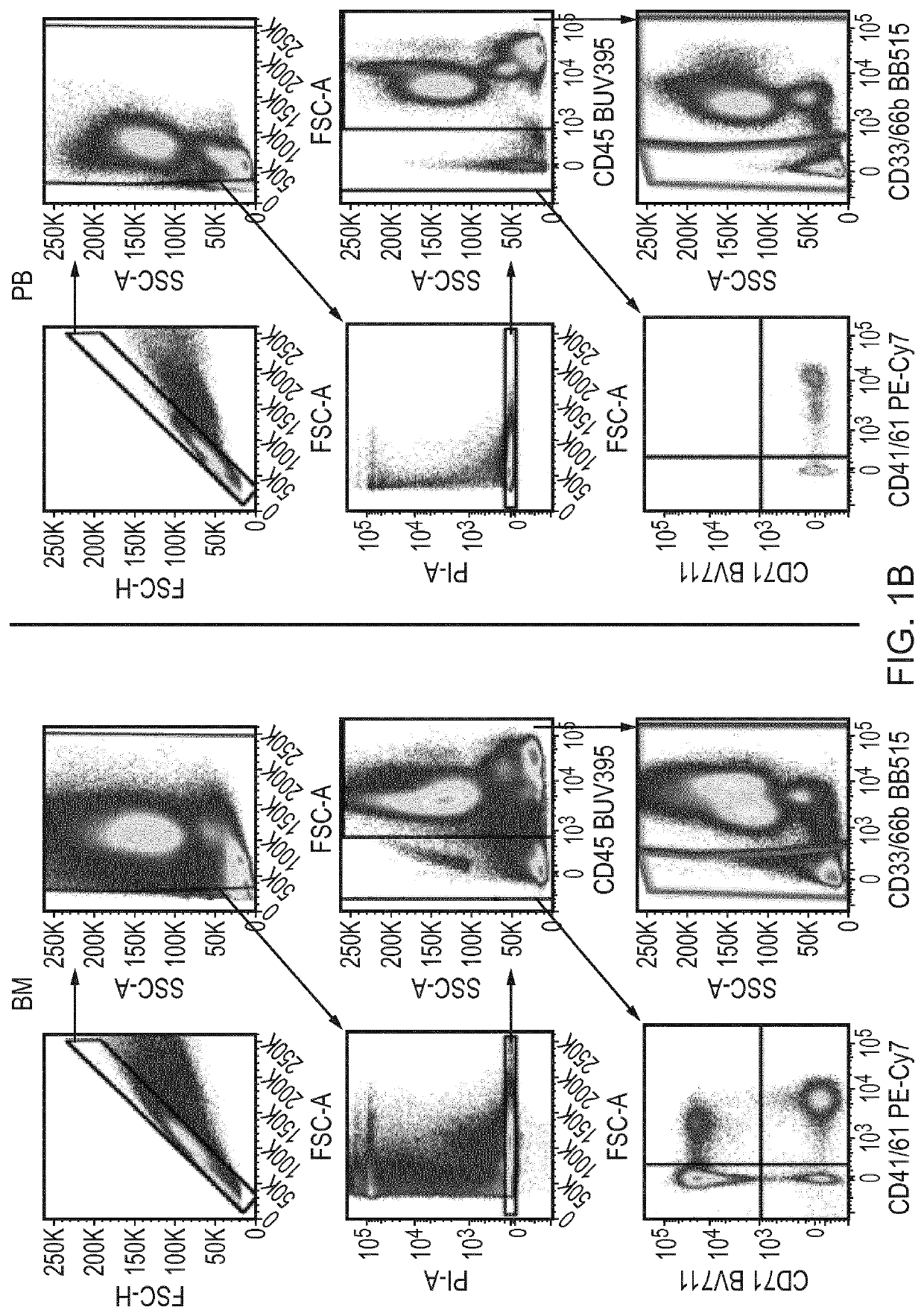Uses, methods, kits, compositions and antibodies for identifying hematopoietic cell subtypes
a technology of hematopoietic cells and antibodies, applied in the field of fluorochrome-labelled antibodies, can solve the problems of unbalanced frequency of immature vs. mature cell types or aberrant cell phenotypes, test requires experienced investigators and time-consuming, and test has limitations for cell quantification. , to achieve the effect of superior coverag
- Summary
- Abstract
- Description
- Claims
- Application Information
AI Technical Summary
Benefits of technology
Problems solved by technology
Method used
Image
Examples
example 1
[0441]Protocol for Determining the Relative Frequency of Hematopoietic Cell Subtypes Present in an Isolated Sample
[0442]Reagent Preparation[0443]RBC lysis buffer: dissolve NH4Cl (Sigma, final concentration: 0.15 M), KHCO3 (Fluka
[0444]BioChemika, final concentration 10 mM) and EDTA Tetrasodium (Fluka BioChemika, final concentration: 0.10 mM) in H2O. Filter the solution with 0.2 μm membrane filter and store at +4° C. for up to three months.[0445]PBS-FACS: prepare the solution adding Bovine Serum Albumin (BSA) (Roche) 0.3% and Na—N3 (Sigma) 0.1% to PBS without Calcium and Magnesium (Gibco). Filter the solution with 0.2 μm membrane filter and store at +4° C.[0446]WORKING SOLUTION (WS): prepare RPMI (Corning) medium complemented with 10% FBS (EuroClone), 1% Pen / Strep and 1% L-Glutammine (Lonza). Dilute the complete medium in PBS without Calcium and Magnesium at 1:1 ratio. Add Hepes (Sigma) to the final concentration of 25 mM. Filter the solution with 0.2 μm membrane filter and store at +...
example 2
[0521]Characterization BM and PB Samples Isolated from Healthy Donors
[0522]To test the efficiency of a method according to the present invention for successfully identifying blood hematopoietic cell subtypes and for reproducibly determining their relative frequency in human BM and PB, 5 BM and 14 PB WB samples from 19 adult (Ad) healthy donors (HD) were analysed (FIGS. 1B-E and 7, and Tables 3-4).
[0523]
TABLE 3Frequencies of bone marrow and peripheral blood hematopoietic cell subtypes in healthy donors as a percentage of total CD45+ cells. Average percentages ± Standard Deviations of hematopoietic cell frequencies on total CD45− (erythroblasts) and on total CD45+ (leukocytes) cells. (* = p Mann-Whitney Test).HD BMHD PBn = 5n = 14% ON CD45−ERYTHROBLAST84.1 ± 8.3***0.14 ± 0.18% ON CD45+MYELOID71.5 ± 11.9ns60.4 ± 12.4iPMN46.6 ± 11.3***2.9 ± 1.3PMN20.6 ± 2.5 *** 51 ± 11.4MONOCYTE3.2 ± 1 *5.5 ± 1.8DC0.3 ± 0.1ns0.4 ± 0.2MYELOBLAST0.7 ± 0.3ns0.7 ± 0.3LYMPHOID25.3 ± 10.7*38.8 ± 12.2T CELL1...
example 3
[0532]Validation by Morphological Assays
[0533]To test whether the protocol according to the present invention was able to properly identify each hematopoietic cell subtype, five independent FACS sorting experiments were performed. The same gating strategy set out in Example 1 was used to isolate different putative cell subpopulations from BM, since BM is a source with the most diverse composition of hematopoietic cell subtypes. Then the morphology of sorted cells was analysed in blind tests to assess whether it was matching their original categorization (FIG. 2B-D). The list of markers used for the five FACS sorting is reported in FIG. 2A and the details of cell isolation and morphological evaluation protocol are described in the material and methods section.
[0534]Importantly, morphological evaluation of all sorted myeloid and lymphoid lineages confirmed that the results of the phenotypic characterization performed through using the protocol according to the present invention were c...
PUM
| Property | Measurement | Unit |
|---|---|---|
| volume | aaaaa | aaaaa |
| volume | aaaaa | aaaaa |
| volume | aaaaa | aaaaa |
Abstract
Description
Claims
Application Information
 Login to View More
Login to View More - R&D
- Intellectual Property
- Life Sciences
- Materials
- Tech Scout
- Unparalleled Data Quality
- Higher Quality Content
- 60% Fewer Hallucinations
Browse by: Latest US Patents, China's latest patents, Technical Efficacy Thesaurus, Application Domain, Technology Topic, Popular Technical Reports.
© 2025 PatSnap. All rights reserved.Legal|Privacy policy|Modern Slavery Act Transparency Statement|Sitemap|About US| Contact US: help@patsnap.com



